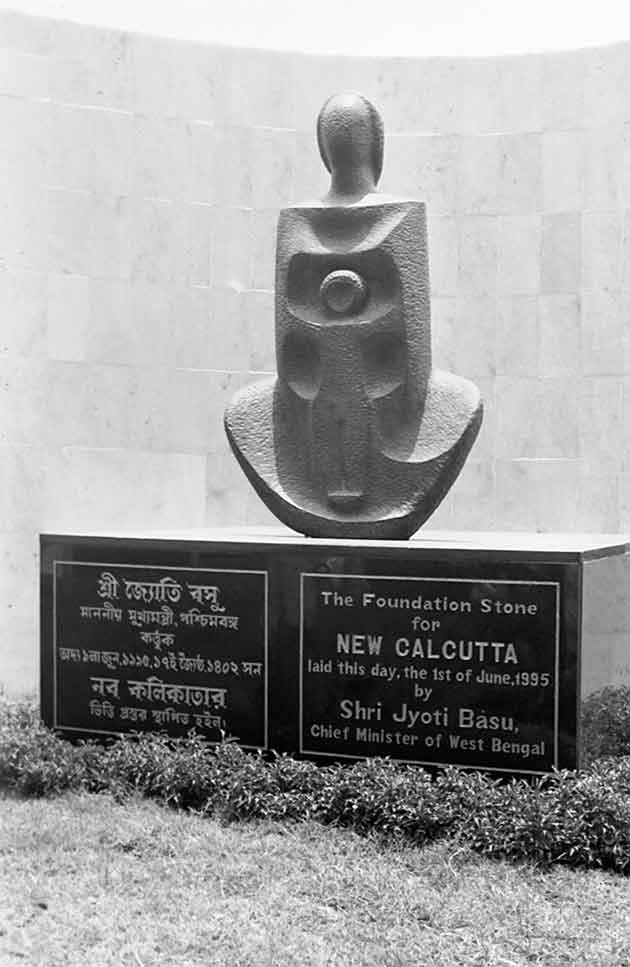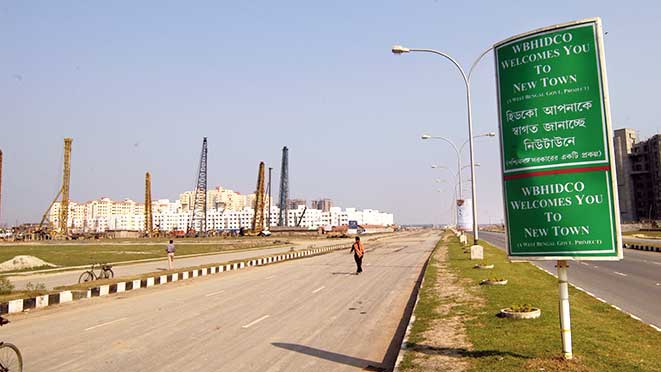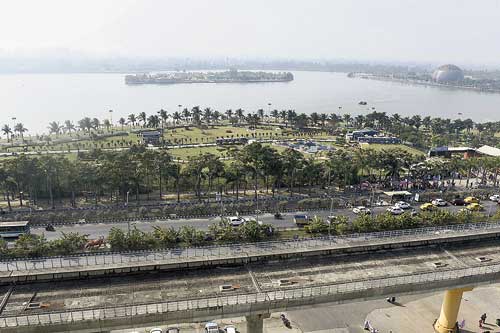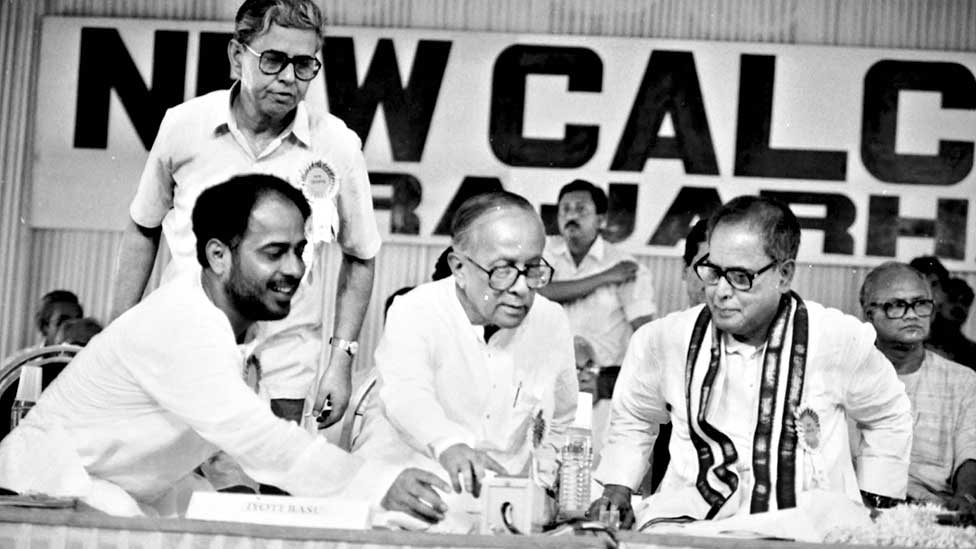New Town was planned under the stewardship of Gautam Deb, the housing and public health engineering minister from 1987 to 2011 in the Left Front regime. A resident of BF Block in Action Area 1B since 2018, the 68-year-old veteran politician has written a book on the evolution of the township, titled Forging An Audacious City: A Participatory Perspective. He speaks to The Telegraph Salt Lake on the formative years of New Town and his evaluation of its genesis.

The foundation stone. Telegraph file pictures
When did you think of writing the book?
After we left the government. I collected various official documents to append to the text to make it as authentic as possible.
How does it feel to stay in a township you helped give birth to?
It is a rare opportunity. City-building is such a stupendous and time-consuming job that it is very rare that the builder gets to see the city ready in his lifetime.
Is it turning out the way you had envisaged?
They (the current government) have compromised to an extent. Because of the recession in the real estate market, big PPPs are on a pause. They can’t sell off all the land even if they want to. Even then, I’d say they could not touch the core of our plan. Drainage, sewerage, roads, electricity, drinking water... I had got everything ready. The township is growing at a much slower pace. We had acquired 7.5km to the east of the Hidco office. The MAR runs across 12.5km. There is nothing towards Hatishala or across the canal near Shapoorji (Sukhobrishti). We did not sell any land that side.

Major Arterial Road in 2005 Telegraph file pictures
Are you happy with the population growth rate in New Town?
There is no reason to be happy. When we were developing the township, land was selling briskly and construction was taking place fast. Now even if people buy land, they are dragging their feet on construction. This is the situation in Calcutta and other metros too. Huge tracts of commercial space are lying idle. If you see the township at night, you can make out in the multi-storeyed buildings how many are lit and how most stay dark.
Did you plan for Metro to pass through New Town?
Initially we had thought of it. Our planning consultant S.K. Roy held meetings with the Metro authorities. New Town was part of their initial plan for Metro in Salt Lake. But the viability report for New Town was weak. We were unsure if the size of population that would be needed to support the extension of the route could be achieved soon enough. So it was decided to end the route at Salt Lake.
But you did not think of a Metro link to the airport.
No, the railways had no such plans. It would have been better if they did. We could have given them what they needed instead of them making do with what they get, like it is the situation now.
We would have taken the route towards Shapoorji (Sukhobrishti), which would have helped residents of New Town more.
Which housing complexes were commissioned in your time?
The first projects were by the housing board. What was there to show here excepts miles of empty fields? I had to make people believe that a city was being built and it was possible to live here. I took up the Major Arterial Road (MAR) first. Then there were to be two clusters of buildings — some close to the Salt Lake end at the southern tip, and then some at the other end, near Haldiram’s under the flyover. The first housing project we took up was East Enclave. After that, some would come up in the middle, like Balaka and Alaka. Then the developers came — Bengal Ambuja (Utsa), Bengal Peerless (Axis Mall, Animikha and Akankha), Bengal Shrachi... Chandan Basu built Greenfield Heights. I invited both Unitech and DLF, who were at loggerheads with each other in Delhi, to come and invest here. The NRIs built Rosedale Garden.

Gautam Deb at his BF Block home in New Town. Sudeshna Banerjee
What were the big challenges you faced when you tried to sell apartments?
It was an uninhabited place that could not be approached from Salt Lake. There were two cuts that separated the landmass — one was Kestopur and another Bagjola. They had to be bridged. It was also low land, needing to be filled up to the height of a full human figure. Where would you get so much clay? We had to dry out all waterbodies in the area, from Nalban up till Sashon, in neighbouring Bhangore. For a month, they were left to dry before we could start excavation. But the top layer could not be used as it would be too soft to support foundations of buildings. So we had to dig from a depth, where the soil was at least 20-30 years old and had achieved the compaction benchmark.
The top layer that we got after drying out the waterbodies was gold, being rich in organic matter. It was very fertile and could support vegetation of all kinds. So we used it at the end at the top. That one year when the waterbodies were off limits for pisciculture, we paid a salary to the fishermen, with us paying half and the fisheries paying half.
The fisheries department was happy as their production went up after that exercise, which is supposed to be done at regular intervals but never was.
What are your memories of those days?
The area looked like a war zone with JCBs and dumpers making trips to and fro with the clay. Bidhan Roy needed two crore cubic meters of sludge for Salt Lake, which he piped in from the Hooghly. We needed 3.5 crore cubic metres for New Town. We excavated two waterbodies to dig up soil for filling up the land. One was the one in Eco Park and the other is parallel to the MAR, on the Nawabpur side, which is slightly smaller over 38 hectares. There was difference of opinion among the engineers whether the soil from the ponds was suitable as foundation. Soil in our state is so soft that it is expensive to make roads in Bengal, except in Purulia or Bankura.
Is there any part of your plan left unfinished?
We were supposed to have brought water from Calcutta down Kestopur Canal and run water transport on it. I had even procured a few launches for this. The canal was navigable even 40 years ago and there were big cargo boats from the Sunderbans coming to Ultadanga Ghat. Our aim was to restore the route from the Hooghly to river Bidyadhari and not let the canal turn into an open sewage line.
We wanted to build a second MAR across Kestopur Canal near Balaka Abasan. A city of one and half million population should not be dependant on only one entry and exit.

Planning Commission deputy chairman K.C Pant (left) with chief minister Buddhadeb Bhattacharya, Jyoti Basu and Gautam Deb at the inauguration of Balaka Abasan, Hidco’s first initiative for economically weaker sections, on January 16, 2003 File Picture
Where had you planned the second MAR?
At that time, there was a plan to construct Eastern Expressway, about 8km to the east of the Eastern Metropolitan Bypass and parallel to it, to connect Madhyamgram and Barasat via Badu and Shashon to Sonarpur. I had requested Buddhada (chief minister Buddhadeb Bhattacharjee) to make the second MAR a part of that expressway.
This MAR was to have started from Derozio College in Rajarhat at the north to 211 Road (Martin Burn Road, colloquially named after the 211 bus route). Land had been acquired and work had started for a few kilometers and survey had been done from the northern border of New Town till Doltala near Madhyamgram.
New Town was to be gradually spread over five Action Areas. We started work on three. We had identified land in Beontia mouza, behind Chak Pachuria, under Bhangor block in South 24-Parganas for a solid waste management plant for New Town. Instead of the existing practice of dumping waste on the land like it is done at Dhapa, an engineer who went to France for exposure as part of an exchange programme, briefed us on a new technique which would need a tenth of the land. An open cast pit would be dug and suitably waterproofed. The waste would be dumped in it. Each pit would take four-five years to fill up when one can proceed to dig the second pit. By the time one will reach the fourth pit, the first will have undergone the required chemical decomposition and could be dug up for use as fertiliser. This way, no new land would be required. The power required to run the plant could be generated from methane and other byproducts of the plant.
There is hue and cry over the lack of a crematorium. You did not plan one.
A crematorium could be part of the solid waste treatment complex. The Kestopur Canal runs by the Beontia mouza. We were in talks with the panchayat to acquire the land when the government changed.

If there is one thing you would change in current New Town, what would it be?
The location of Eco Park. It is a disaster. It will have to be dismantled in future. Can you imagine an entertainment park coming up in Dalhousie Square with children crossing the traffic-heavy main road? Already, they have labelled it an accident-prone area. The High Court will come up here, hotels will be built here, the consulates will come.
It was planned as a 48-hectare lung of the township, like the Maidan is for Calcutta. The lake is not a bheri but an artificial waterbody that we had dug for soil. So many people came to me for the land, including Sourav Ganguly. I had refused as no construction should happen there. Now you have people staying in rooms, binging on sweets at the shop, doing water sports…They did not consult the transport department or the earlier planners.
Do you agree with Gautam Deb’s views on the current New Town? Write to The Telegraph Salt Lake, 6 Prafulla Sarkar Street, Calcutta 700001 or email to saltlake@abp.in











